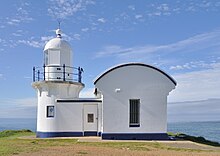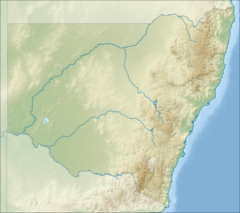Tacking Point Lighthouse

Tacking Point Lighthouse, 2012
|
|
|
New South Wales
|
|
| Location |
Port Macquarie New South Wales Australia |
|---|---|
| Coordinates | 31°28′32″S 152°56′14″E / 31.4755°S 152.9372°ECoordinates: 31°28′32″S 152°56′14″E / 31.4755°S 152.9372°E |
| Year first constructed | 1879 |
| Automated | 1919 |
| Construction | cement render bricks |
| Tower shape | cylindrical tower with balcony and lantern |
| Markings / pattern | white tower, lantern and attached storeroom, blue balcony rail |
| Height | 8 m (26 ft) |
| Focal height | 34 m (111 ft) |
| Light source | mains power |
| Intensity | 12,800 cd |
| Range | 16 nmi (30 km; 18 mi) |
| Characteristic | Fl (4) W 20s. |
| Admiralty number | K2788 |
| NGA number | 111-6024 |
| ARLHS number | AUS-158 |
| Managing agent | Australian Maritime Safety Authority |
Tacking Point Lighthouse is Australia's third oldest lighthouse. It was built on a rocky headland about 8 kilometres south of Port Macquarie in 1879 by Shepherd and Joseph William Mortley, to a design by the New South Wales Colonial Architect, James Barnet. It is operated by the Australian Maritime Safety Authority and is classified by the National Trust of Australia (NSW).
Tacking Point was named by explorer Matthew Flinders in 1802 during his 1802–1803 circumnavigation of Australia. Its nearest lighthouses are Smoky Cape Lighthouse at South West Rocks, to the north, and Crowdy Head Light, to the south.
In the mid-nineteenth century, there were few lights in the Tacking Point area and over 20 ships were wrecked. The first wrecks occurred in 1823 and were the schooner Black Joe and the steamer Sumatra. Consequently, in 1879, a fixed catadioptric light of less than 1000 candelas was erected on Tacking Point. It was the fourth of five small navigational lighthouses built to a design by James Barnet. The other four lighthouses were Crowdy Head Light, Fingal Head Light, Richmond River Light and Clarence River Light (now demolished). Only two of these lighthouses, Tacking Point and Crowdy Head still have a storeroom attached.
The lighthouse was built of cement-rendered bricks and only needed to be 8 metres high due to the elevation of the site. In 1919, the light was converted from wick oil light to automatic acetylene operation, and was demanned in 1920. The light was converted to mains electricity in 1974. The foundations of the keeper's cottage are still visible.
...
Wikipedia

